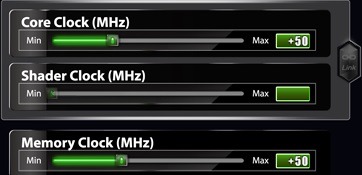

- MSI AFTERBURNER MEMORY CLOCK SOFTWARE
- MSI AFTERBURNER MEMORY CLOCK PC
- MSI AFTERBURNER MEMORY CLOCK WINDOWS
In technical terms, it is the frequency of the graphic processing chip. In a nutshell, the core clock is the speed at which your GPU’s cores process data. So, if you are comparing the GPU speed, compare both clock speeds.
MSI AFTERBURNER MEMORY CLOCK SOFTWARE
With software such as MSI Afterburner, you can take that to a maximum of 1.9 GHz.Īpart from core clock speed, memory clock speed is another significant factor. That said, most quality graphic cards have a core clock of 1.44 GHz. You must keep other factors in mind which make a graphics card desirable. What Is a Good Core Clock Speed?įirstly, the core clock is not the only metric against which you can judge the working of a graphics card. Lastly, the method isn’t specific to a company or generation. The method has been tested and implemented repeatedly, and no downsides have been found. If you’re worried that this increment will harm your computer, don’t be. You’ll see a noticeable increase in the FPS. That’s it! You can go and run all the games you want.
MSI AFTERBURNER MEMORY CLOCK WINDOWS
MSI AFTERBURNER MEMORY CLOCK PC
At most, if the temperature and load increase off the limit, your PC will freeze or crash. It is no secret that you can get better graphics performance by overclocking your PC, but the question remains: how do you do it, and is it safe? For the latter, be assured that overclocking will cause no harm to your PC. Their speed has to be synchronized so that VRAM doesn’t put too much data that the cores cannot process.įrom an operational perspective, core clocks affect your PC’s performance more than the memory clock. VRAM retrieves visual data from memory and throws it toward the cores.

You can think of the relationship between the memory clock and the core clock in the following way. In contrast, the core clock signifies the processing speed. In other words, it’s the frequency of the VRAM on the GPU. The memory clock is the speed of memory processing on the GPU. But if you want greater clock speed and the memory input isn’t overwhelming, you can compromise on the core counts. You might consider buying more core counts if you want to process a lot of visual data in a small time window. What should you prefer if you’re getting all the same specs but different core counts and core clocks? The core count is the number of cores in your graphics card, while the core clock is the speed at which these cores work. Clock speed is just a quantitative measure of the core clock. The faster it oscillates, the better the results will be.

Technically, it is the frequency at which the graphic processing chip oscillates. It implies the more core a graphics card has, the more computation power it has.Ĭore clock is a term coined to describe the speed of the GPU cores. For starters, cores are the basic computing units of the GPU that work in parallel. To understand what the core clock means, we’ll first get the hang of what cores in GPU are in the first place.


 0 kommentar(er)
0 kommentar(er)
